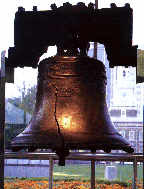
United States The Liberty Bell
The Liberty Bell

Cast 1752
Cast in London, England in 1752, the Liberty Bell rang when the Continental Congress signed the Declaration of Independence and has become the symbol of freedom in the United States. The bell weighs about 2000 pounds and is made mostly of copper (70%) and tin (25%).
United States The Liberty Bell: The Liberty Bell
Made for the Pennsylvania State House (now Independence Hall), the Bell, cracked shortly after its arrival in Philadelphia. Local craftsmen recast the bell using the metal from the old bell, but this one also proved defective. A third was cast by John Pass and John Stowe. Their names appear on the bell, along with the city and date, along with this inscription:
"Proclaim liberty throughout all the land unto all the inhabitants thereof - Lev. XXV, v. x. By order of the Assembly of the Province of Pensylvania [sic] for the State House in Philada.
NOTE: The spelling of "Pennsylvania" was not at that time universally adopted. Pensylvania was an accepted alternative spelling throughout the 1700's.
On June 7, 1753, the bell was hung in the tower of Independence Hall; however, during the American Revolution, in 1777, British troops captured Philadelphia. For safekeeping, the bell was moved to Zion's Reformed Church in Allentown, Pennsylvania. It was returned to Philadelphia in 1778.
As tradition, the bell was rung on every July 4th and on every state occasion until 1846. By 1846, a crack had formed that affected the sound of the bell. The last time the bell rang was on February 23, 1846 for George Washington's birthday celebration. Today, the Liberty Bell hangs in Philadelphia at the Liberty Bell Pavilion on Market Street for all to see.
To learn more, check out the National Park Service's Liberty Bell.







